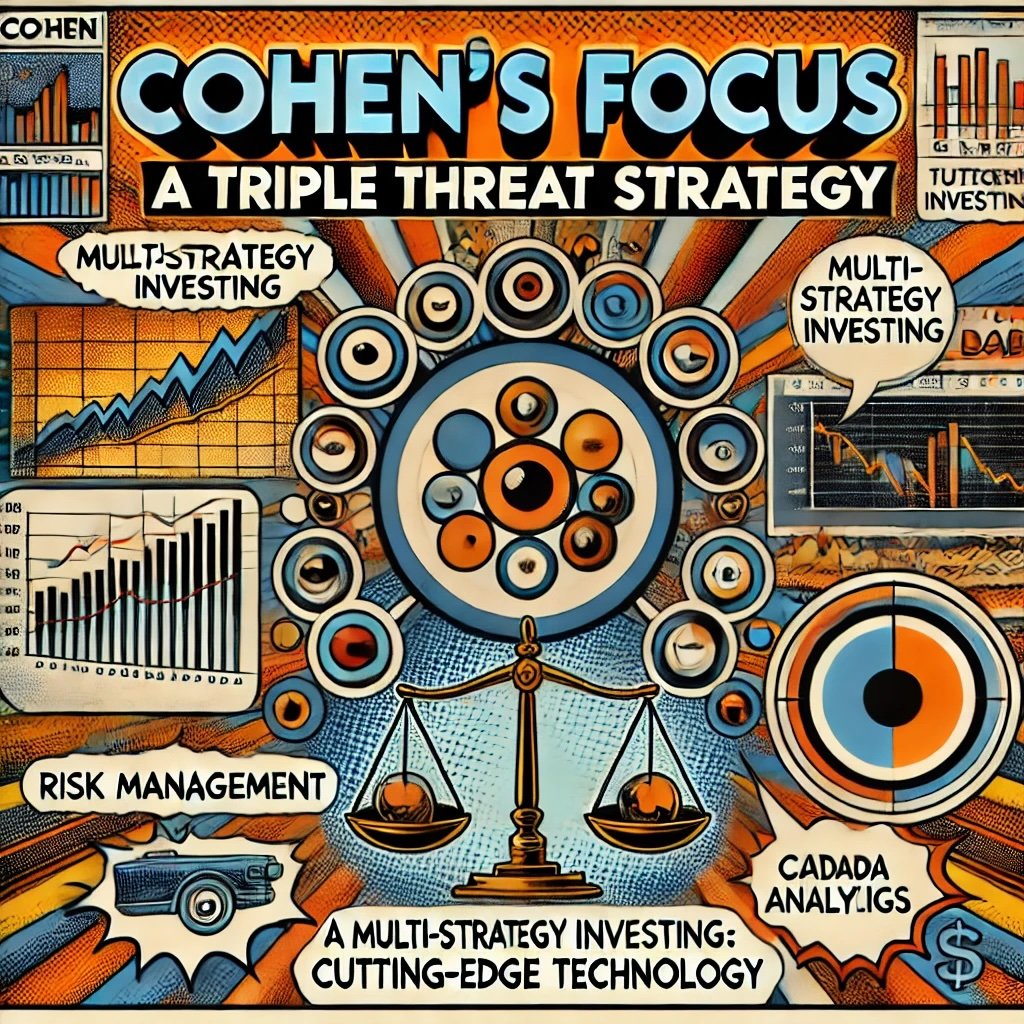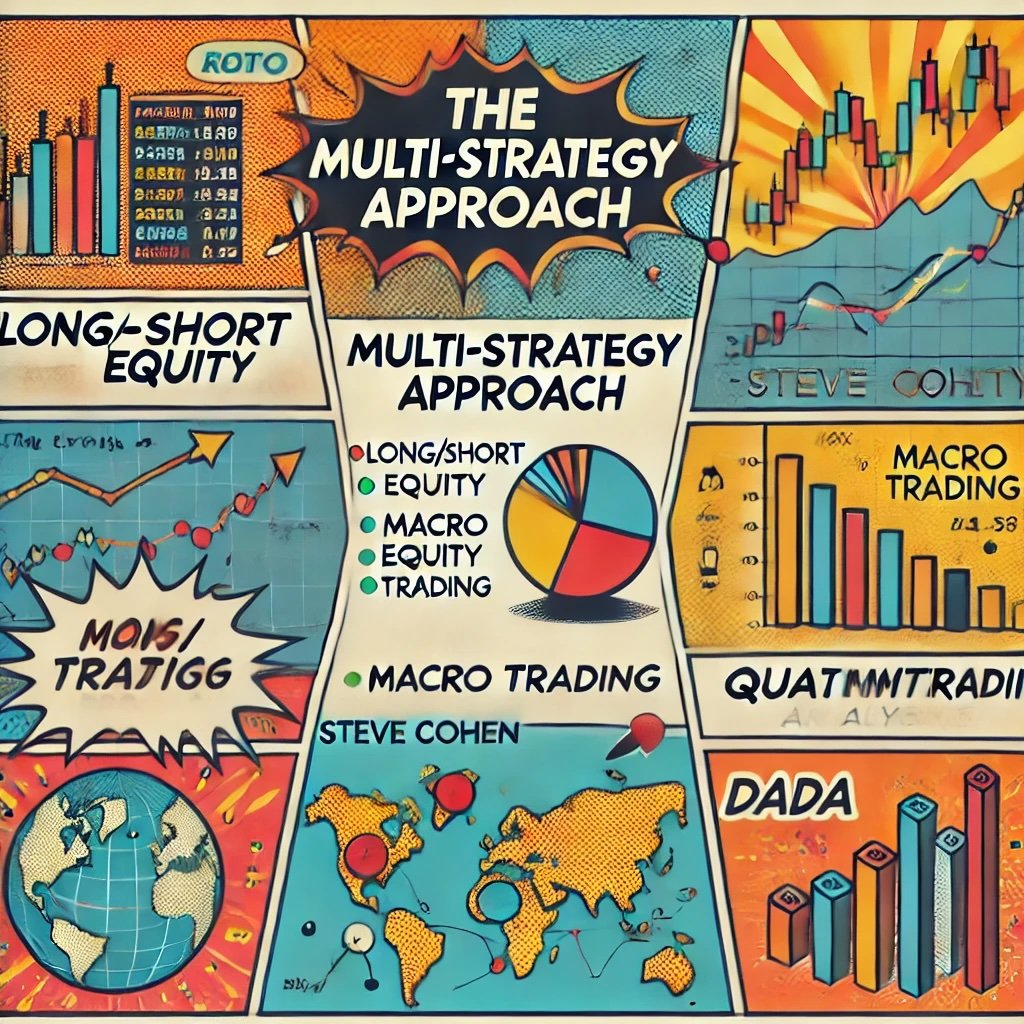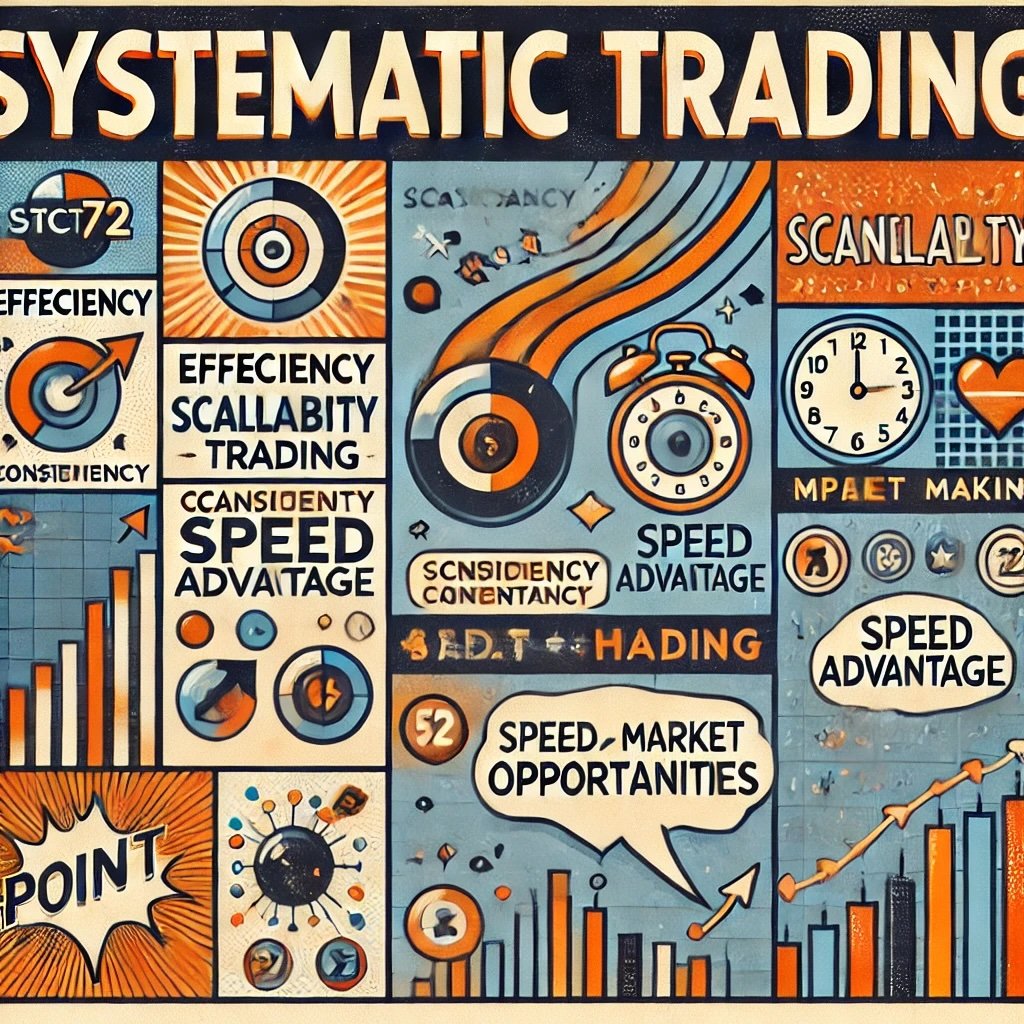When it comes to the titans of Wall Street, Steve Cohen is a name that resonates with both awe and intrigue. As the founder of Point72 Asset Management, Cohen has carved out a reputation as a savvy investor with an uncanny ability to navigate the complex waters of the financial markets. With a career spanning decades, he’s transformed Point72 into a powerhouse that not only manages billions in assets but also sets the bar for innovation in investing.
source: FRONTLINE PBS | Official on YouTube
Meet Steve Cohen: The Man Behind Point72
So, what’s the secret sauce behind Cohen’s success? And more importantly, how can you tap into his strategies to enhance your own investment game? The purpose of this article is to explore Cohen’s investment strategy and how it is applied at Point72. We’ll delve into his focus on multi-strategy investing, robust risk management, and the utilization of cutting-edge technology. Whether you’re an aspiring investor or a seasoned pro, there’s a wealth of knowledge to be gleaned from Cohen’s approach.

Cohen’s Focus: A Triple Threat Strategy
Steve Cohen doesn’t believe in putting all his eggs in one basket. His investment philosophy revolves around three core pillars:
- Multi-Strategy Investing: Diversifying across various investment strategies to capture opportunities in different market conditions.
- Risk Management: Implementing rigorous processes to mitigate risks and protect capital.
- Cutting-Edge Technology: Leveraging advanced tools and data analytics to gain a competitive edge.
Tip for Best Practices: Diversification isn’t just about spreading investments across different assets; it’s about employing multiple strategies to navigate varying market landscapes.

The Man Behind the Success
Cohen started his career in the late ’70s, trading options and honing his skills. Over the years, he’s become known for his keen eye for talent and his ability to adapt to market changes. At Point72, he fosters a culture of innovation and continuous learning, encouraging his team to push boundaries and think outside the box.
- Innovation Enthusiast: Cohen is a strong proponent of incorporating technology into investing, embracing everything from algorithmic trading to artificial intelligence.
- Talent Developer: He places a high value on cultivating talent, understanding that a strong team is crucial for success.
What You’ll Learn
In this article, we’ll unpack:
- The Multi-Strategy Approach: How diversifying strategies can lead to consistent returns.
- Risk Management Techniques: Methods used by Point72 to protect investments.
- Technological Edge: The role of technology in enhancing investment decisions.
By the end, you’ll have a clearer picture of how Steve Cohen has built a formidable investment firm and how you can apply some of these principles yourself.
Tip for Best Practices: Continuous learning and adaptability are key. The market is ever-changing, and staying ahead requires both knowledge and flexibility.
Setting the Stage
Investing like Steve Cohen isn’t about mimicking his trades; it’s about understanding the underlying principles that drive his success. It’s about:
- Embracing complexity while seeking simplicity in execution.
- Balancing risk with potential reward.
- Leveraging technology without losing the human touch.
Bold Move: Are you ready to rethink your investment strategy and incorporate some of Cohen’s tried-and-true methods? Let’s dive in!

The Multi-Strategy Approach
What Is Multi-Strategy Investing?
Imagine having a toolbox filled with a variety of instruments, each designed for a specific task. That’s essentially what multi-strategy investing is all about. It’s a diversified investment approach where multiple strategies are employed simultaneously to generate returns. At Point72, Steve Cohen doesn’t rely on a single path to success. Instead, he combines various strategies like long/short equity, macro trading, and quantitative analysis to navigate the complex financial markets.
But what does this mean in practice?
- Long/Short Equity: Betting on stocks expected to rise (long positions) while shorting stocks anticipated to fall. This allows for profit opportunities in both bullish and bearish markets.
- Macro Trading: Making investment decisions based on global economic trends, interest rates, and geopolitical events.
- Quantitative Trading: Using mathematical models and algorithms to identify trading opportunities that might be invisible to the naked eye.
Tip for Best Practices: Diversify your investment strategies to spread risk and increase the potential for consistent returns.
Why Multi-Strategy?
So, why go through the hassle of juggling multiple strategies? The answer lies in the benefits of reducing risk and achieving consistent returns across different market environments.
Benefits of Multi-Strategy Investing
- Risk Reduction: By not putting all your eggs in one basket, you mitigate the impact if one strategy underperforms.
- Consistent Returns: Different strategies perform well under varying market conditions. Combining them can smooth out the ups and downs.
- Opportunity Capture: Multiple strategies allow you to seize a broader range of market opportunities.
Bold Move: Adopting a multi-strategy approach isn’t just smart—it’s essential in today’s unpredictable markets.
Navigating Different Market Conditions
Markets are like the weather—constantly changing and sometimes unpredictable. A multi-strategy approach equips Point72 to adapt swiftly to these changes.
- In Volatile Markets: Macro and quantitative strategies can identify trends and anomalies.
- In Stable Markets: Long/short equity strategies can capitalize on stock-specific movements.
Tip for Best Practices: Stay flexible and be prepared to adjust your strategies as market conditions evolve.

How Point72 Puts It Into Action
At Point72, the multi-strategy approach is more than just a concept—it’s the foundation of their success.
Diversification in Practice
- Global Reach: Point72 invests in markets around the world, spreading geographical risk.
- Sector Focus: Specialized teams focus on sectors like technology, healthcare, and energy to leverage expert insights.
- Technology Integration: Advanced analytics and machine learning enhance their quantitative strategies.
Balancing Risk and Reward
Point72 continuously adjusts the allocation of resources among different strategies based on performance and market outlook.
- Dynamic Allocation: If quantitative models indicate favorable conditions, more capital might flow into quant strategies.
- Risk Monitoring: Real-time data and analytics help in making swift decisions to manage exposure.
Example: During a period of market uncertainty, Point72 leveraged its macro trading strategies to hedge against potential downturns while its long/short equity teams focused on sectors showing resilience.
Tip for Best Practices: Regularly review your portfolio and be willing to rebalance to maintain an optimal mix of strategies.

Quantitative and Systematic Strategies
Incorporating Technology: Enhancing Decision-Making with Data Science
In today’s fast-paced financial markets, embracing technology isn’t just an advantage—it’s a necessity. Point72 has been at the forefront of this technological integration, utilizing quantitative models and data science to sharpen their investment decisions.
At Point72, technology serves as a catalyst for uncovering hidden patterns and insights that traditional analysis might miss.
- Advanced Analytics: By leveraging machine learning algorithms, Point72 analyzes vast datasets to identify trends and anomalies.
- Predictive Modeling: They employ statistical models to forecast market movements, helping them stay ahead of the curve.
- Alternative Data Sources: Incorporating non-traditional data like social media sentiment, satellite imagery, and transactional data provides a more comprehensive market view.
Tip for Best Practices: Consider learning basic data analysis skills or using platforms that offer analytical tools to enhance your investment research.

Systematic Trading: The Role of Algorithms and High-Frequency Trading
Systematic trading at Point72 involves using algorithms to execute trades based on predefined criteria, minimizing human emotion and error.
Algorithmic Trading
Algorithms execute trades when specific market conditions are met.
- Efficiency: Automates the trading process, allowing for quicker execution than manual trading.
- Consistency: Ensures trading strategies are applied uniformly, reducing inconsistencies.
- Scalability: Can handle large volumes of trades simultaneously.
High-Frequency Trading (HFT)
HFT is a subset of algorithmic trading that focuses on executing a high number of trades at extremely fast speeds.
- Speed Advantage: Leverages cutting-edge technology to execute trades in microseconds.
- Market Making: Provides liquidity to the markets, profiting from small price differentials.
- Arbitrage Opportunities: Exploits brief price discrepancies across different markets or securities.
Bold Move: While HFT requires significant resources and infrastructure, understanding its impact can help you better comprehend market movements.
Example: How Point72’s Quant Strategies Boost Performance
Let’s look at how Point72’s quantitative strategies contribute to their success.
Case Study: Data-Driven Stock Selection
Point72 was interested in a retail company that appeared stable but unremarkable based on traditional metrics. By digging deeper with quantitative analysis:
- Consumer Behavior Analysis: They used data science to analyze credit card transactions, revealing a surge in purchases at the company’s stores.
- Supply Chain Insights: Satellite images of distribution centers showed increased activity, indicating higher inventory turnover.
- Social Media Trends: Sentiment analysis of social platforms pointed to a growing consumer interest.
Armed with this data, Point72 took a significant position in the company before its stock price surged following a strong earnings report.
Tip for Best Practices: Explore alternative data sources to gain insights that might not be evident through conventional analysis.
Integrating Quant with Traditional Strategies
Point72 doesn’t rely solely on algorithms; they blend quantitative methods with fundamental analysis.
- Cross-Verification: Quant models identify potential opportunities, which are then vetted by human analysts.
- Risk Management: Algorithms monitor market conditions in real-time, allowing for swift adjustments to positions.
- Continuous Improvement: Machine learning models adapt over time, refining strategies based on new data.
Final Thought: The synergy between human expertise and technological innovation is a key driver of Point72’s performance.

Risk Management at Point72
Dynamic Risk Management: Cohen’s Approach to Mitigating Risk
In the high-stakes world of investing, risk management isn’t just a safety net—it’s a lifeline. Steve Cohen understands this better than most. At Point72, risk management is dynamic and multifaceted, involving diversification, hedging, and real-time monitoring.
Diversification
Cohen believes in not putting all your eggs in one basket. By diversifying across various asset classes, strategies, and geographies, Point72 reduces the impact of any single investment’s poor performance.
- Multi-Strategy Investing: Employing different strategies like long/short equity, macro trading, and quantitative analysis.
- Global Reach: Investing in markets worldwide to spread geographical risk.
- Sector Variety: Allocating resources across multiple industries to avoid sector-specific downturns.
Tip for Best Practices: Diversify your own portfolio to mitigate risk. Consider spreading investments across different sectors and asset classes.
Hedging Strategies
To protect against adverse market movements, Point72 employs sophisticated hedging techniques.
- Options and Futures: Using derivatives to hedge positions and limit potential losses.
- Short Selling: Taking positions that profit from declines in asset prices to offset potential losses in other areas.
- Currency Hedging: Managing foreign exchange risk in international investments.
Bold Move: Hedging isn’t just for big firms. Individual investors can also use options and other instruments to protect their portfolios.
Real-Time Monitoring
In today’s fast-paced markets, timely information is crucial. Point72 utilizes advanced technology for real-time monitoring of positions and market conditions.
- Advanced Analytics: Implementing algorithms that track market data and flag potential risks.
- Risk Dashboards: Visual tools that provide an overview of the firm’s exposure at any given moment.
- Instant Alerts: Systems that notify traders and risk managers of significant market events.
Tip for Best Practices: Use financial apps or platforms that offer real-time data and alerts to stay on top of your investments.
Position Sizing and Stop-Losses: Managing Individual Trade Risks
Risk management at Point72 isn’t just about the big picture; it drills down to each individual trade.
Position Sizing
Determining the appropriate size for each position is key to managing risk.
- Risk-Adjusted Positions: Allocating more capital to high-confidence trades and less to riskier ones.
- Capital Allocation Models: Using quantitative models to decide how much to invest in each position.
- Portfolio Limits: Setting maximum exposure limits to prevent any single trade from disproportionately affecting the portfolio.
Tip for Best Practices: In your own investing, avoid over-allocating to a single stock or asset. Balance is crucial.
Stop-Loss Orders
To limit potential losses, Point72 makes strategic use of stop-loss orders.
- Predefined Exit Points: Setting price levels at which positions are automatically sold to prevent further losses.
- Discipline Over Emotion: Automating exits helps avoid the trap of holding onto losing positions in the hope they’ll rebound.
- Dynamic Adjustments: Regularly reviewing and adjusting stop-loss levels based on market conditions.
Bold Move: Implement stop-loss orders in your own trading to manage downside risk effectively.
Example: Navigating Market Volatility
Let’s look at how Point72’s risk management strategies help navigate market volatility.
The Scenario
Financial markets can be unpredictable, with sudden shifts due to economic data, geopolitical events, or unexpected crises.
- Market Fluctuations: Rapid changes in asset prices can impact portfolio performance.
- Uncertainty: External events can introduce new risks.
Point72’s Response
- Proactive Risk Assessment: Continuously evaluating potential risks and adjusting strategies accordingly.
- Dynamic Hedging: Utilizing hedging techniques to protect portfolios against unfavorable movements.
- Adjusting Exposure: Modifying position sizes in response to changing risk assessments.
The Outcome
By maintaining a robust risk management framework, Point72 aims to minimize losses during turbulent times and capitalize on opportunities that arise from market shifts.
Tip for Best Practices: In times of market uncertainty, reassess your portfolio. Don’t hesitate to adjust your strategies to align with new realities.

Talent Development and Team Structure
Hiring the Best: Cohen’s Quest for Top Talent
At Point72, Steve Cohen firmly believes that a company’s greatest asset is its people. To maintain a competitive edge in the fast-paced world of finance, Cohen focuses on attracting top-tier talent across various disciplines—including portfolio managers, analysts, and quantitative researchers (quants).
- Portfolio Managers: Seasoned professionals with a proven track record of delivering consistent returns. They possess deep market insights and the ability to navigate complex investment landscapes.
- Analysts: Sharp minds who excel at fundamental analysis, dissecting financial statements, and understanding market trends to identify investment opportunities.
- Quants: Experts in mathematics, statistics, and computer science who develop sophisticated models to predict market movements and optimize trading strategies.
Tip for Best Practices: Surround yourself with individuals who complement your skills and challenge your perspectives. A diverse team can uncover opportunities you might miss on your own.
Training and Mentorship: Cultivating Excellence
Hiring talented individuals is just the beginning. At Point72, there’s a strong emphasis on continuous development through rigorous training and mentorship programs. Cohen understands that the financial markets are ever-evolving, and staying ahead requires a commitment to learning.
- Structured Training Programs: New hires undergo comprehensive training to familiarize themselves with the firm’s strategies, tools, and culture.
- Mentorship Opportunities: Experienced professionals mentor newcomers, providing guidance, sharing insights, and fostering professional growth.
- Ongoing Education: Regular workshops, seminars, and guest lectures keep the team updated on the latest market developments and technological advancements.
Bold Move: Investing in your team’s growth not only enhances their skills but also drives the overall success of your organization.
Point72 Academy: Nurturing New Talent
A shining example of Cohen’s commitment to talent development is the Point72 Academy. Established to train the next generation of investment professionals, the Academy is a highly selective program designed for recent graduates and early-career individuals.
What Is Point72 Academy?
The Point72 Academy is a full-time training ground where participants learn the fundamentals of investing and gain hands-on experience.
- Selective Admission: The program attracts candidates from top universities worldwide, ensuring a cohort of high-caliber individuals.
- Comprehensive Curriculum: Covers a wide range of topics, including equity research, financial modeling, risk management, and compliance.
- Practical Experience: Trainees work on real projects, analyze live data, and participate in simulated trading environments.
- Mentorship and Feedback: Each participant is paired with a mentor who provides personalized guidance and constructive feedback.
Tip for Best Practices: If you’re an aspiring investor, seek out programs or opportunities that offer both education and practical experience. Real-world application is key to mastering any skill.
The Academy’s Impact on Point72
The Academy serves as a talent pipeline for Point72, ensuring a steady flow of well-trained professionals who are aligned with the firm’s culture and values.
- Internal Growth: Many graduates transition into full-time roles within Point72, contributing fresh perspectives and innovative ideas.
- Cultural Cohesion: Early immersion in the firm’s ethos fosters a strong sense of belonging and commitment.
- Innovation Drive: Young talent often brings new approaches to problem-solving, fueling the firm’s adaptability and competitiveness.
Example: A recent Academy graduate developed a new quantitative model that improved the firm’s trading efficiency, showcasing how nurturing talent can lead to tangible benefits.
Building a Collaborative Culture
Beyond individual development, Cohen emphasizes the importance of a collaborative team structure. Open communication and teamwork are integral to Point72’s operational philosophy.
- Cross-Functional Teams: Encouraging collaboration between different departments—such as combining the insights of analysts with the technical expertise of quants.
- Knowledge Sharing: Regular meetings and informal discussions promote the exchange of ideas and best practices.
- Recognition and Rewards: Acknowledging team achievements boosts morale and motivates continued excellence.
Tip for Best Practices: Foster an environment where team members feel valued and empowered to contribute. Collaboration often leads to innovation.

Adapting to Market Conditions
Flexibility and Adaptation: How Point72 Adjusts Its Strategies
In the fast-paced world of finance, rigidity can be a downfall. Steve Cohen and his team at Point72 understand that markets are ever-evolving landscapes. What works today might not work tomorrow. That’s why they place a strong emphasis on flexibility and adaptation, continually adjusting their strategies to align with current market conditions.
Staying Agile in a Dynamic Market
- Diversified Strategies: Point72 doesn’t rely on a single investment approach. By employing multiple strategies—such as long/short equity, macro trading, and quantitative analysis—they can pivot when one method underperforms.
- Real-Time Data Analysis: Utilizing cutting-edge technology, they monitor market trends and economic indicators in real time, allowing for swift strategic adjustments.
- Continuous Learning: The team is encouraged to stay informed about global events, regulatory changes, and industry developments to anticipate market shifts.
Tip for Best Practices: Be open to revising your investment strategies as new information emerges. Flexibility can be a significant advantage in navigating market fluctuations.
Market Timing: The Importance of Entry and Exit Strategies
Timing isn’t just about luck; it’s about meticulous analysis and disciplined execution. At Point72, market timing plays a crucial role in maximizing returns and minimizing risks.
Mastering the Art of Timing
- Technical Analysis: They study price charts and market trends to identify optimal entry and exit points.
- Fundamental Analysis: By evaluating a company’s financial health and industry position, they determine when to invest or divest.
- Sentiment Analysis: Gauging investor sentiment through news outlets, social media, and market data helps them anticipate market movements.
Disciplined Execution
- Set Targets and Limits: Establishing clear profit targets and stop-loss levels to manage each position effectively.
- Avoiding Emotional Decisions: Sticking to predefined strategies prevents knee-jerk reactions to market volatility.
- Regular Reviews: Continuously reassessing positions to ensure they align with current market conditions and investment goals.
Tip for Best Practices: Develop a systematic approach to timing your trades. Combining different analytical methods can provide a more comprehensive view of the market.
Example: Adapting During Market Shifts
While specific proprietary strategies at Point72 are confidential, it’s widely recognized that Steve Cohen has successfully navigated various market environments by adapting his firm’s approaches.
Navigating Economic Uncertainty
- Adjusting Portfolio Exposure: In periods of economic downturn, Point72 may reduce exposure to volatile sectors and focus on more resilient industries.
- Seizing Opportunities: Market corrections can present buying opportunities. Point72 positions itself to capitalize on undervalued assets during these times.
- Hedging Strategies: Implementing hedges to protect against adverse market movements helps preserve capital.
Tip for Best Practices: During uncertain times, consider rebalancing your portfolio to reflect your risk tolerance and the current economic outlook.
Responding to Regulatory Changes
- Monitoring Policy Developments: Keeping an eye on changes in regulations that could impact specific industries or the broader market.
- Strategic Pivoting: Adjusting investment strategies to align with new regulatory environments, ensuring compliance and capitalizing on new opportunities.
- Engaging Experts: Consulting with legal and industry experts to fully understand the implications of regulatory shifts.
Final Thought: By staying flexible and responsive, Point72 exemplifies how adaptability is essential for long-term success in investing.

The Role of Technology and Data
Embracing Cutting-Edge Technology at Point72
In the modern financial landscape, technology isn’t just an advantage—it’s a necessity. Steve Cohen recognizes this and has integrated cutting-edge technology into the very fabric of Point72’s operations. From advanced analytics to machine learning, the firm leverages the latest technological advancements to stay ahead of the curve.
But what does this integration look like?
- Advanced Analytics: Point72 uses sophisticated analytical tools to process vast amounts of financial data. This allows them to identify patterns and trends that might be invisible to the naked eye.
- Machine Learning: By implementing machine learning algorithms, the firm can make predictions based on historical data, improving the accuracy of their investment decisions.
- Big Data Processing: Handling large datasets is crucial. Point72 employs big data technologies to manage and analyze information from diverse sources, including market feeds, news articles, and even social media.
Tip for Best Practices: Consider familiarizing yourself with basic data analytics tools. Even a rudimentary understanding can enhance your investment research and decision-making.
Data-Driven Decisions: Leveraging Information for Success
At Point72, data isn’t just collected—it’s transformed into actionable insights. Steve Cohen emphasizes the importance of data-driven decisions to enhance trading strategies and improve portfolio performance.
How Data Drives Decisions at Point72
- Quantitative Analysis: The firm uses quantitative models to assess investment opportunities objectively. This reduces emotional bias and relies on statistical evidence.
- Real-Time Data Monitoring: By keeping an eye on live market data, Point72 can make timely decisions, capitalizing on fleeting opportunities.
- Risk Assessment: Data analytics help in evaluating the risk associated with different investments, allowing for more informed choices.
Bold Move: Embracing data-driven strategies can significantly improve your investment outcomes. It shifts the focus from intuition to evidence-based decision-making.
The Human Touch
Despite the heavy reliance on technology, Point72 doesn’t eliminate the human element. Instead, technology and data augment the expertise of their analysts and traders.
- Collaborative Environment: Data scientists work alongside portfolio managers to interpret data findings within the context of market knowledge.
- Continuous Learning: The team stays updated on technological advancements to continually refine their strategies.
Tip for Best Practices: Combine data insights with your personal experience and market understanding. Technology should complement, not replace, your investment acumen.
Example: Technological Innovations at Point72
While specific proprietary technologies at Point72 are confidential, the firm’s commitment to innovation is well-known.
Artificial Intelligence and Machine Learning
Point72 has invested in artificial intelligence (AI) to enhance its trading algorithms.
- Natural Language Processing (NLP): By using NLP, the firm can analyze news articles, earnings reports, and other textual data to gauge market sentiment.
- Predictive Modeling: Machine learning models help predict stock movements by analyzing historical data and identifying predictive patterns.
Real-World Impact: These technologies enable Point72 to react quickly to market changes, often gaining an edge over competitors who rely on traditional analysis methods.
Integration of Alternative Data Sources
To get a more comprehensive view of the market, Point72 incorporates alternative data.
- Satellite Imagery: Analyzing satellite images of retail parking lots or shipping ports can provide insights into economic activity.
- Social Media Analytics: Monitoring social media trends helps gauge public sentiment toward companies or products.
Tip for Best Practices: Explore alternative data sources available to individual investors. Platforms offering sentiment analysis or economic indicators can enrich your research.
Investment in Tech Talent
Recognizing that technology is only as good as the people behind it, Point72 actively recruits top tech talent.
- Data Scientists and Engineers: These professionals develop and maintain the firm’s advanced technological infrastructure.
- Collaboration with Academia: Partnerships with universities and research institutions keep Point72 at the forefront of technological innovation.
Final Thought: By investing in both technology and the people who wield it, Point72 creates a synergistic environment where data-driven strategies thrive.

Practical Steps to Implement Cohen’s Strategy
Building a Multi-Strategy Portfolio
Embarking on the path to invest like Steve Cohen begins with embracing a multi-strategy portfolio. This approach isn’t exclusive to hedge fund titans; individual investors can adopt it to enhance diversification and potential returns. By combining various investment strategies, you can create a robust portfolio capable of weathering different market conditions.
Start by assessing your current investments and identifying areas where you might be overly concentrated. Diversification is key:
- Asset Classes: Allocate your assets across stocks, bonds, commodities, and real estate.
- Equities: Invest in a mix of large-cap, mid-cap, and small-cap stocks to balance growth and stability.
- Fixed Income: Include government and corporate bonds to provide steady income and reduce volatility.
- Alternative Investments: Consider real estate investment trusts (REITs), commodities, or even cryptocurrencies for additional diversification.
- Investment Strategies: Blend different approaches within your asset classes.
- Value Investing: Seek undervalued companies with strong fundamentals.
- Growth Investing: Target companies with high growth potential.
- Income Investing: Focus on dividend-paying stocks or interest-bearing assets.
- Geographical Diversification: Expand beyond domestic markets.
- International Exposure: Invest in global markets to capitalize on international growth opportunities.
- Emerging Markets: Consider allocating a portion to emerging economies for higher growth potential.
Tip for Best Practices: Regularly review and rebalance your portfolio to maintain your desired asset allocation. Market movements can shift your allocations over time, so staying proactive ensures alignment with your investment goals.
Incorporating Quantitative Analysis
Integrating quantitative and systematic strategies into your investment process can enhance decision-making by grounding it in data and reducing emotional biases. Here’s how to get started:
Leverage Technology and Tools
- Investment Platforms: Use platforms offering analytical tools and real-time data.
- Robo-Advisors: Consider services that utilize algorithms to manage portfolios based on your risk tolerance and goals.
- Analytical Software: Tools like Excel, or more advanced programs like Python with financial libraries, can help analyze data effectively.
- Financial Metrics: Familiarize yourself with key quantitative indicators.
- Price-to-Earnings (P/E) Ratio: Assesses a company’s current share price relative to its per-share earnings.
- Return on Equity (ROE): Measures profitability by revealing how much profit a company generates with shareholders’ equity.
- Earnings Growth Rates: Evaluates the rate at which a company’s earnings are increasing.
Tip for Best Practices: Start by applying quantitative analysis to a small portion of your portfolio. As you gain confidence, you can expand its use.
Educate Yourself
- Online Courses: Enroll in courses on quantitative finance or data analysis.
- Reading Material: Books like “A Random Walk Down Wall Street” can provide valuable insights.
- Financial Blogs and Forums: Engage with communities to stay updated on quantitative strategies.
Bullet Points to Remember:
- Backtesting: Test your strategies against historical data to gauge potential performance.
- Combine Analyses: Use quantitative methods alongside fundamental and technical analysis for a comprehensive view.
- Stay Updated: Technology and markets evolve rapidly; continuous learning is essential.
Risk Management Techniques
Protecting your investments is as crucial as growing them. Implementing Cohen’s risk management principles can help safeguard your portfolio:
Implement Stop-Loss Orders
- Set Clear Limits: Determine the maximum loss you’re willing to accept on any investment.
- Automate Exits: Use stop-loss orders to automatically sell a security when it reaches a certain price, preventing emotional decision-making.
Diversify to Mitigate Risk
- Avoid Overexposure: Don’t allocate too much capital to a single investment or sector.
- Hedging Strategies: Use options or inverse ETFs to protect against market downturns.
Tip for Best Practices: Regularly reassess your risk tolerance and adjust your strategies accordingly, especially during volatile market periods.
Stay Informed and Flexible
- Monitor Market Conditions: Keep an eye on economic indicators, news events, and market sentiment.
- Be Ready to Adapt: Adjust your investment strategies in response to significant market changes or new information.
Effective Risk Management:
- Discipline: Stick to your investment plan and avoid impulsive decisions.
- Liquidity Considerations: Ensure you have sufficient liquidity to navigate unforeseen circumstances.
- Regular Reviews: Schedule periodic portfolio reviews to stay aligned with your goals.

How to Invest Like Steve Cohen — Point72 Strategy Explained: 12-Question FAQ
What defines Steve Cohen’s core investing philosophy?
Cohen runs a multi-strategy, research-intensive playbook that blends discretionary stock-picking with systematic/quant edges. The aim is to create a repeatable process that works across regimes: idea generation → risk-adjusted sizing → tight risk controls → rapid feedback and iteration.
What does “multi-strategy” mean at Point72?
It means capital is spread across long/short equity sector pods, macro/derivatives, and quant/systematic sleeves. Each strategy has its own edge and risk limits, so different return engines can work at different times, smoothing the firm’s overall P&L.
How does Point72 generate ideas day-to-day?
Three streams:
Fundamental research (channel checks, models, mosaic theory),
Quant signals (stat-arb, factor/alt-data models),
Catalyst calendars (events like earnings, FDA, product launches).
Ideas are scored, stress-tested, and sized only if they clear risk/return hurdles.
What role does technology and data play?
A big one. Teams use machine learning, NLP, and alt-data (e.g., web traffic, credit-card panels) to augment human research. Tech is used to discover signals, monitor exposures in real time, and enforce guardrails—not to replace analyst judgment.
How is risk managed at the firm level?
Through layered limits: single-name caps, sector/industry caps, factor and beta bands, gross/net exposure ranges, stop-losses, and firmwide drawdown brakes. Real-time dashboards surface factor drift, crowdedness, liquidity, and scenario shocks.
How is risk managed at the position level?
Every trade has: a thesis, a time frame, a clear invalidation level, and position size set by volatility and liquidity. If price action or new info invalidates the thesis, the position is cut fast—winners are pressed only when risk stays contained.
How do the discretionary and quant teams work together?
Quant teams scan for patterns, factor exposures, alt-data edges, and risk concentrations. Discretionary teams provide context (unit economics, competitive dynamics, management quality). The result is cross-verification—signals with both data and narrative support.
What does talent development look like (e.g., Point72 Academy)?
Hiring favors domain depth + process discipline. The Academy pipeline trains juniors in modeling, variant perception, compliance, and risk. The cultural goal: independent thinkers who can defend a view and change it quickly when facts change.
How does Cohen think about market regimes?
He assumes regimes change often. Hence the bias toward breadth of strategies, short feedback loops, and adaptive risk (dialing gross/net up in benign regimes; down and more market-neutral in stressed ones). Flexibility beats prediction.
What are common mistakes retail investors make trying to copy this?
Running one strategy through all regimes
Oversizing high-conviction ideas without hard stops
Ignoring factor risk (e.g., hidden small-cap or duration tilts)
Treating alt-data or backtests as truth rather than hypotheses to validate
How can an individual adapt the Point72 playbook at home?
Build a personal multi-strategy (e.g., core long/short + small rules-based sleeve).
Use checklists for entries/exits, valuation, and catalysts.
Track exposures (beta, sector, factors) and cap single-name risk.
Institute hard risk rules: max loss per position/day/week; pre-planned deleveraging.
What’s a simple “starter framework” inspired by Cohen/Point72?
Idea pipeline: 5–10 names with clear catalysts and variants
Sizing: risk-based (e.g., 0.5–1.0% max loss per position)
Stops: technical + thesis-based; trail winners
Quant assist: a small systematic screen (e.g., earnings-drift + quality factor)
Review cadence: weekly exposure audit; monthly post-mortems
Summing Up Cohen’s Investment Mastery
As we wrap up our deep dive into Steve Cohen’s investment strategy at Point72, it’s clear that his approach is a blend of sophistication, adaptability, and relentless innovation. Cohen doesn’t rely on a single tactic or market trend. Instead, he orchestrates a symphony of strategies that work in harmony to achieve consistent returns.
Let’s recap the key takeaways from Cohen’s investment playbook:
- Multi-Strategy Approach: Diversifying across various investment strategies—such as long/short equity, macro trading, and quantitative analysis—to capitalize on different market conditions.
- Embracing Technology: Leveraging cutting-edge technology and data analytics to gain insights and execute trades with precision.
- Robust Risk Management: Implementing dynamic risk management techniques, including diversification, hedging, and real-time monitoring, to protect capital.
- Talent Development: Investing in people through training and mentorship programs to build a team that’s both skilled and innovative.
- Flexibility and Adaptation: Staying agile and adjusting strategies in response to changing market landscapes.
Tip for Best Practices: Regularly revisit and assess your investment strategies. Markets evolve, and so should your approach. Staying stagnant is not an option in the dynamic world of investing.
The Pillars of Long-Term Success
Cohen’s success isn’t just a result of savvy stock picks or timely trades. It’s built on foundational principles that any investor can appreciate—and adopt.
Diversification
By not putting all eggs in one basket, Cohen reduces risk and opens up multiple avenues for returns. Diversification isn’t merely about holding different stocks; it’s about embracing various asset classes, sectors, and even investment styles.
- Asset Variety: Including stocks, bonds, commodities, and real estate.
- Sector Spread: Investing across technology, healthcare, finance, and more.
- Geographical Reach: Exploring opportunities in both developed and emerging markets.
Bold Move: Challenge yourself to step out of your comfort zone. Diversify into new sectors or asset classes to uncover hidden opportunities.
Risk Management
Protecting your capital is just as important as growing it. Cohen’s meticulous risk management strategies ensure that losses are minimized when markets turn volatile.
- Dynamic Hedging: Using financial instruments to offset potential losses.
- Position Sizing: Allocating capital in a way that no single loss can significantly impact the portfolio.
- Stop-Loss Orders: Setting predetermined exit points to prevent small losses from becoming large ones.
Tip for Best Practices: Establish clear risk management rules for your investments. Discipline in this area can safeguard your portfolio during turbulent times.
Innovation
In an era where information is abundant and markets are increasingly efficient, staying ahead requires innovation. Cohen’s adoption of technology and data analytics exemplifies how innovation drives success.
- Advanced Analytics: Utilizing machine learning and AI to analyze market data.
- Systematic Trading: Employing algorithms for timely and efficient trade execution.
- Continuous Learning: Keeping abreast of technological advancements to maintain a competitive edge.
Final Thought: Innovation isn’t exclusive to technology. It can be as simple as adopting a new investment approach or thinking differently about market trends.
Your Turn: Applying Cohen’s Strategies
Now that we’ve unpacked the elements of Cohen’s strategy, it’s time to consider how you can apply these principles to your own investment journey.
Start Small, Think Big
You don’t need a massive portfolio to implement these strategies. Begin by incorporating elements that align with your investment goals and risk tolerance.
- Diversify Your Portfolio: Even modest investments can be diversified. Use mutual funds or ETFs to gain broad exposure.
- Leverage Technology: Utilize investment apps and online platforms that offer analytical tools and data.
- Manage Risks: Set stop-loss orders and regularly review your positions.
Stay Educated and Informed
The markets won’t wait for you to catch up. Commit to continuous learning.
- Read Widely: Books, financial news, and blogs can provide valuable insights.
- Join Communities: Engage with investment groups or forums to exchange ideas.
- Attend Webinars and Workshops: These can offer deeper dives into specific investment strategies or market analyses.
Encouragement: Remember, every expert was once a beginner. The key is to stay curious and proactive in enhancing your investment acumen.
Embrace Adaptability
Be prepared to adjust your strategies as markets evolve. Flexibility can be a significant asset.
- Monitor Market Trends: Keep an eye on economic indicators and global events.
- Reassess Regularly: Don’t hesitate to pivot if a strategy isn’t yielding the desired results.
- Stay Open-Minded: Be willing to explore new investment vehicles or methodologies.
Tip for Best Practices: Set aside time each quarter to evaluate your investment approach and make necessary adjustments.
Important Information
Comprehensive Investment Disclaimer:
All content provided on this website (including but not limited to portfolio ideas, fund analyses, investment strategies, commentary on market conditions, and discussions regarding leverage) is strictly for educational, informational, and illustrative purposes only. The information does not constitute financial, investment, tax, accounting, or legal advice. Opinions, strategies, and ideas presented herein represent personal perspectives, are based on independent research and publicly available information, and do not necessarily reflect the views or official positions of any third-party organizations, institutions, or affiliates.
Investing in financial markets inherently carries substantial risks, including but not limited to market volatility, economic uncertainties, geopolitical developments, and liquidity risks. You must be fully aware that there is always the potential for partial or total loss of your principal investment. Additionally, the use of leverage or leveraged financial products significantly increases risk exposure by amplifying both potential gains and potential losses, and thus is not appropriate or advisable for all investors. Using leverage may result in losing more than your initial invested capital, incurring margin calls, experiencing substantial interest costs, or suffering severe financial distress.
Past performance indicators, including historical data, backtesting results, and hypothetical scenarios, should never be viewed as guarantees or reliable predictions of future performance. Any examples provided are purely hypothetical and intended only for illustration purposes. Performance benchmarks, such as market indexes mentioned on this site, are theoretical and are not directly investable. While diligent efforts are made to provide accurate and current information, “Picture Perfect Portfolios” does not warrant, represent, or guarantee the accuracy, completeness, or timeliness of any information provided. Errors, inaccuracies, or outdated information may exist.
Users of this website are strongly encouraged to independently verify all information, conduct comprehensive research and due diligence, and engage with qualified financial, investment, tax, or legal professionals before making any investment or financial decisions. The responsibility for making informed investment decisions rests entirely with the individual. “Picture Perfect Portfolios” explicitly disclaims all liability for any direct, indirect, incidental, special, consequential, or other losses or damages incurred, financial or otherwise, arising out of reliance upon, or use of, any content or information presented on this website.
By accessing, reading, and utilizing the content on this website, you expressly acknowledge, understand, accept, and agree to abide by these terms and conditions. Please consult the full and detailed disclaimer available elsewhere on this website for further clarification and additional important disclosures. Read the complete disclaimer here.




